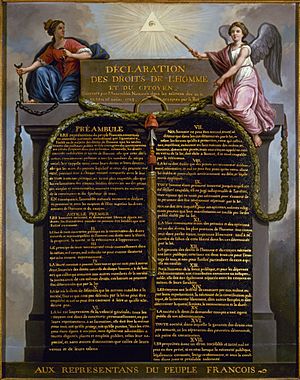Declaration of the Rights of Man and of the Citizen facts for kids

The Declaration of the Rights of Man and of the Citizen (which in French is La Déclaration des droits de l'Homme et du citoyen) is a very important paper from the French Revolution. It was written in 1789. This document lists many basic rights that all people should have.
These rights include things like freedom of religion (the right to believe what you want). It also includes freedom of speech (the right to say what you think). Other rights are freedom of assembly (the right to gather peacefully). The paper also talks about separation of powers in government.
The Declaration was based on ideas called "natural rights." These are rights that people are born with. They are believed to be true for everyone, everywhere, at all times. They are part of being human.
The final version of the Declaration was agreed upon on August 26, 1789. This happened during a meeting of the National Constituent Assembly. This Assembly was a group of people who represented the French nation. The Declaration was a key first step before France could write its new constitution.
The document explained these basic rights for "all men without exception." However, it did not mention the rights of women. It also did not talk about slavery. Even so, many people today see it as a big step towards international human rights. It helped lead to documents like the Universal Declaration of Human Rights.
The first article of the Declaration says: "Men are born and remain free and equal in rights. Social distinctions can be founded only on the common utility."
The ideas in this Declaration are still important in French law today. They can be used to challenge or change new laws. They also help guide government actions. French law is built on the ideas from this document.
Images for kids
See also
 In Spanish: Declaración de los Derechos del Hombre y del Ciudadano para niños
In Spanish: Declaración de los Derechos del Hombre y del Ciudadano para niños



